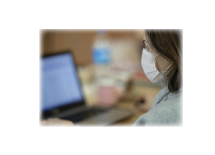By Chris Kittleson, Director of Loss Control Technical Services - Public Risk Underwriters of Florida, Inc
Many public entities are contemplating a return to the traditional workplace. But a reintroduction to office life during the COVID-19 pandemic presents its own set of exposures. Organizations that fail to properly plan to mitigate these exposures may place their employees and their organization at risk.
An effective plan for reintegrating into the regular business premises needs to maintain safety, manage resources and rebuild morale. Below are six essential considerations to ensure a successful transition back to work.
Physical Conditions - Preparing the Physical Workplace for Return to Work
A major consideration every organization should evaluate before issuing a return-to-work order are the practices they have adopted to promote a safe physical environment for workers.
Employers should develop procedures for building maintenance and care, maintaining physical distance, and mitigating risks for employees who need to perform work in public environments that are outside of the organization’s control.
Medical Health Considerations - Protecting the Health of Workers Before and After Returning to the Workplace
Prioritizing the physical health of workers as they return to the workplace is key to protecting their physical safety. Employers should develop procedures for monitoring and promoting the medical health of the workforce, ensuring appropriate physical distancing, and encouraging overall good hygiene and infection control practices.
Stress, Emotional & Mental Health Considerations - Providing Employees Support Needed to Return to Work
The safety and physical health of employees is top of mind for organizations as they look to reopen workplaces and have workforces return. Another set of considerations for employers is how they intend to allay the concerns, anxieties and uncertainty that workers may feel about their jobs and the future of the organization when returning to work. Additionally, employees may have experienced high levels of stress associated with financial, employment, food or housing instabilities, the long-term effects of which may continue to impact employees’ return to work and their ability to safely focus on the job at hand.
Extended social isolation increases risk for the development of mental health issues and substance use disorders, can exacerbate pre-existing conditions, and increases the risk of relapse or deterioration for people in recovery. Isolation is a well-documented risk factor for suicide, and connectedness is one of the best protective factors that helps to increase people’s resilience and buffer them against the risk of suicide.
Employment, Legal & HR Considerations - Preparing the Workforce to Transition Back to the Workplace
A major consideration beyond the protocols to address the physical, medical, emotional and mental issues of reopening the workplace is the cumulative level of change that employees have experienced over weeks and months. Workers will undoubtedly have many questions and/or anxieties about transitioning back to a physical work environment, in terms of both their safety and health as well as disruption to what has become the “new normal” of sheltering in place and/or working from home. Employers need to proactively identify potential problems and solutions. Cross-functional partnership at the leadership level will help ensure the workforce is physically and psychologically prepared to return.
Communication Considerations - Ensuring Effective and Timely Communication to Facilitate Return to Work
Effective, timely and frequent communication is necessary to create the shared sense of safety and security among a workforce and ease the process of returning to work. In addition to including the details of the transition, a communications plan should anticipate employee concerns and questions. The right communication tactics can exhibit enhanced caring from leadership and help employees practice better awareness of their surroundings for physical distancing and more.
External Considerations - Raising Awareness of the Outside Influences That Can Impact Operations
As employers work to develop comprehensive continuation and/or return to work plans, changes in environmental and societal conditions outside of one’s organizational control will need to be continually considered. As part of their efforts to address COVID-19 precautions, employers should develop protocols that can be adjusted based on external needs and shifts in policy, medical guidance and overall levels of community risk. These must be flexible and should be relative to city, county, state, and federal guidelines and levels of risk (e.g. infection growth rate, population density), which may vary greatly in organizations with large footprints. By doing this, organizations can set themselves up for continued safe operations without needing to create new protocols in response to external influences.
Please refer to the following resources to assist with your COVID-19 Back to Work Transition Planning and/or contact your Regional Loss Control Consultant for assistance.
Preferred Resources
• Target Solutions – https://www.targetsolutions.com/covid-19/
• Training Network Now – https://www.trainingnetworknow.com/
• My Community Workplace – www.mycommunityworkplace.com
• Enquiron Support Center – www.pgitsupport.com
• J.J. Keller – https://www.jjkeller.com/learn/pandemic-response
• Lexipol Coronavirus (COVID-19) Learning & Resource Center – https://coronavirus.lexipol.com

Professional Association Resources
• NSC – https://www.nsc.org/work-safety/safety-topics/coronavirus
• ASSP – https://www.assp.org/resources/covid-19/latest-resources
• Infectious Disease Society of America – https://www.idsociety.org/public-health/COVID-19-Resource-Center/
• FFSHC – https://www.floridafirefightersafety.org/programs-resources/covid-19-resources
Government Resources
• OSHA – https://www.osha.gov/SLTC/covid-19/
• NIH – https://www.nih.gov/coronavirus
• US Dept. of Education – https://www.ed.gov/coronavirus?src=feature
• CDC – https://www.cdc.gov/coronavirus/2019-nCoV/index.html
• World Health Org. – https://www.who.int/emergencies/diseases/novel-coronavirus-2019
• Dept. of Homeland Security – https://www.dhs.gov/
• National Council for Behavioral Health – https://www.thenationalcouncil.org/covid19/
• National Center for PTSD – https://www.ptsd.va.gov/covid/index.asp
• Florida Dept. of Health – https://floridahealthcovid19.gov/
• Dept. of Labor – https://www.dol.gov/coronavirus
• FEMA – https://www.fema.gov/coronavirus
• Dept. of Transportation – https://www.transportation.gov/coronavirus


